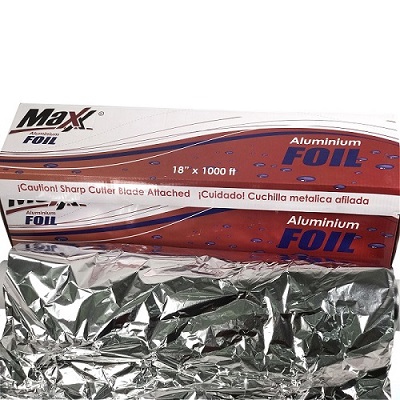We are committed to food packaging PVC cling film, PE cling film,stretch wrap, aluminum foil and other disposal food packing film/foil.

Language
>Max Aluminum Foil, renowned for its quality and versatility, undergoes a meticulous manufacturing process to ensure excellence from raw materials to the finished product. Let's embark on a journey to explore the intricate steps involved in crafting this essential kitchen tool.

1. Raw Material Selection:
The journey of Max Aluminum Foil begins with the careful selection of raw materials. High-quality aluminum ingots, sourced from reputable suppliers, serve as the foundation for the foil's superior performance. These ingots undergo rigorous quality checks to ensure purity and consistency, setting the stage for the manufacturing process.
2. Casting and Rolling:
Once the raw aluminum ingots pass quality inspection, they are melted and cast into massive slabs through a process called casting. These slabs are then fed into rolling mills, where they undergo a series of rolling and annealing processes. The rolling process reduces the thickness of the aluminum to the desired gauge, while annealing imparts strength and flexibility to the foil.
3. Foil Milling and Slitting:
After rolling, the aluminum sheets are processed through specialized foil mills, where they are stretched and thinned to achieve the desired foil thickness. Precision slitting machines then cut the continuous sheets into narrower rolls of various widths, catering to different packaging and consumer needs.
4. Surface Treatment and Coating:
Surface treatment and coating processes are employed to enhance the foil's properties and performance. This may include applying lubricants or coatings to improve the foil's non-stick properties, enhance its heat resistance, or provide barrier protection against moisture, odors, and contaminants.
5. Quality Control Checks:
Throughout the manufacturing process, stringent quality control measures are implemented to ensure adherence to specifications and standards. Automated inspection systems monitor the foil for defects, thickness variations, and surface imperfections, ensuring that only foil of the highest quality advances to the next stage.
6. Finishing and Packaging:
Once the foil passes quality control checks, it undergoes final finishing processes, which may include trimming, cutting, or embossing to meet specific customer requirements. The finished foil rolls are then carefully packaged and labeled, ready for distribution to retailers, wholesalers, and consumers worldwide.
7. Environmental Considerations:
In addition to quality and performance, Max Aluminum Foil prioritizes environmental sustainability throughout the manufacturing process. Efforts are made to minimize waste, conserve energy, and reduce emissions, ensuring responsible and eco-friendly production practices.
The manufacturing process of Max Aluminum Foil is a testament to precision, innovation, and commitment to excellence. From the careful selection of raw materials to the final finishing touches, each step is executed with meticulous attention to detail to produce foil of unparalleled quality and performance. As a result, Max Aluminum Foil emerges as the preferred choice for chefs, home cooks, and packaging professionals seeking reliability, versatility, and superior performance in the kitchen and beyond.